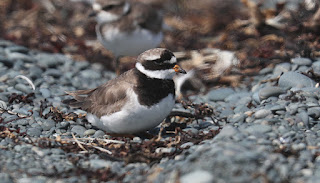I arrived at Portugal Cove South on the southern Avalon Peninsula just as Alison Mews and Alvan Buckley were getting out of the car on 19 Aug 2017. Alvan quickly spotted a suspicious plover that we were kind of looking for after he had a brief look at a highly likely Common Ringed Plover the weekend before in the fog. Yup - it was a COMMON RINGED PLOVER alright. The big black ring around the neck, strong distinct white supercilium and distinct black markings on the head made it stick out. But was it the same bird the had been at Biscay Bay 29 July to 3 Aug and then again at nearby Trepassey 5-7 August?
Photography was very difficult with the heat shimmer rising off the dark coarse sand of Portugal Cove South beach (PCS). But the photos were enough to show that the PCS bird was different than the Biscay Bay bird. The plovers can greatly changed how the width of their breast band and facial markings look depending on the mood of the bird = relaxed vs hyper active. Taking this into account the PCS still had a wider black bar and narrower white space on forecrown. The black tip on the bill covers about 50% of the bill tip on the PCS bird but only 33% on the Biscay Bay bird. Besides that the bird seemed to have a larger or more contrasting white supercilium, possibly slightly darker upper parts and different tone of orange legs and bill base. Bottom line is that the PCS bird is going down as a new bird and 3rd of the summer of 2017 in Newfoundland.
Common Ringed Plover 19 Aug 2017 at Portugal Cove South.
Common Ringed Plover 19 Aug 2017 at Portugal Cove South.
Common Ringed Plover 19 Aug 2017 at Portugal Cove South.
Common Ringed Plover 19 Aug 2017 at Portugal Cove South.
Common Ringed Plover 30 July 2017 at Biscay Bay.
---------------------------------------------------------------------------------------------------
On a different note, an arguably rarer shorebird in Newfoundland is the Stilt Sandpiper. An unexpected three individuals, each an immaculate juvenile, showed up this weekend on the Avalon Peninsula.
Two juvenile Stilt Sandpipers at Renews 19-20 Aug 2017
One juvenile Stilt Sandpiper at Cape Broyle 19-20 Aug 2017
























































